CLAWING ALONG THE FACE OF BIRD ROCK
July 2020
I was anchoring rowing boats on Nefyn Beach on a July evening in the late 1950's when another young fisherman Dafydd Hughes suggested we go for some mackerel down to Carreg Llam (Bird Rock). He told his father and off we went in his motorboat. It was a quiet evening and the sea was like glass, calm and serene, and we were down by Bird Rock in less than an hour. We picked up a couple of dozen mackerel in no time and we had just made the turn to head for home, when the engine suddenly stopped dead! Dafydd looked at me and unscrewed the cap on the engine and said “O'r Arglwydd da ni allan o betrol, mi anghofais i gael peth bora ma!” (O Lord we are out of petrol, I forgot to get some this morning!) and he shook an empty container under the deck.
We were less than a hundred yards off the south side of Bird Rock. There was no means of communicating from a boat in those days and there were no mobile phones. Hardly any people in Nefyn even had a regular house phone. The motorboat was not built to use oars and there were none available. “Be na ni rwan?” (What are we going to do now?) was the next natural question. We had an anchor so we could drop it and wait for someone to come and give us a tow. But there were no other boats in sight and none were likely to appear since it was late in the day. We would be stuck there overnight and that was not an option we were willing to accept.
After pondering for a minute, Dafydd picked up a couple of planks wedged in on either side of the bottom boards and decided we should use those as paddles to try and get to shore. So with one of us standing on each side of the boat, we started paddling. The planks were sufficiently long but not wide enough to provide a lot of paddle power and it was difficult to get much boat movement out of them. Paddling a light canoe sitting down, with wide paddles and a comfortable grip, is no problem but paddling a heavy, clinker built motorboat standing up, with planks as makeshift paddles and an awkward grip, is another story. We were not making a lot of progress and our hands were getting sore. We were losing some forward movement due to the boat's bow wavering back and forth and we thought it was due to the rudder being loose. Dafydd tied the tiller fast with a mackerel line to keep the rudder dead centre. We noticed an improvement right away and kept on going.
The closest point to shore from the boat was the corner of Bae Pistyll by the sea stack named Llech Lydan (so named on the local UK ordnance survey map) at the south side of Bird Rock and we decided to try and get there. It was a good spot to land since one of us could then run up the cliffs to the Plas Pistyll Hotel or Pistyll Farm where we could get some petrol. We kept at it for a long time but as we finally approached the stack, we realized we were not going to reach our target. The flow tide was strong and it made us miss the south side of Llech Lydan. The tide carried us just a bit to the north side of the stack and into the corner of the front face of Bird Rock.
Having that towering slab of granite suddenly fill our field of vision was an overwhelming feeling. It was something I had experienced before while lobster fishing with my father. Bird Rock is a steep, near-vertical cliff dropping straight into the sea from a height of approximately 250 feet. It is as wide as it is high and having reached shore, we now had to keep within an arms length of the Rock and somehow maneuver along its entire width. There was no going back against the tide but missing the target was not yet a lost cause. As shown in the rough map below, on the north side of Bird Rock was Bae Nant and the Carreg y Llam Quarry where we could possibly get petrol if someone at the quarry was still working. We proceeded trying to move along the front face of the Rock as best we could.
We started with one of us paddling on the seaward side of the boat and the other searching the rock surface for anywhere to grab to pull the boat along. It was faster than being in the open sea but it was not straightforward. The rock had a slimy green growth in shady areas making it difficult to secure a good grip. Patches of barnacles helped on occasions but their sharpness also dug into fingers. In other areas there were plenty of places to grab. It was then better to have us both on the same side clawing along the rock face, one in the bow and the other in the middle of the boat, alternating each of our efforts. Other spots were polished smooth and again we paddled one side and flat-palmed the other side letting the boat just slide along. When the boat was pushed away by an underwater protrusion so we could not reach the face or when we came to the cave opening, we again resorted to paddling both sides to get past the obstacle or the cavern entrance. We alternated between those options as we moved along. It was a struggle but we made better progress. The Welsh phrase that best described our action was “crafangu ar hyd wyneb y graig” (claw along the face of the rock).
We kept our eyes focused straight ahead because the damn seagulls were a nuisance. Bird Rock, as the name implies, is home to every breed of North Atlantic seagull and seabird you can imagine. They nest, in their respective colonies, on almost every ledge on the rock surface above the storm surf level. That is why Bird Rock has that bright white luster in the summer months. Early July is the worst period, when the young gulls have hatched and are fully grown but are unable to fly. They are fed well by their parents and I swear they are trained to turn their backsides seaward and to propel outwards. It showers down on anyone stupid enough to be within an arm's length of the rock and it splashes everywhere. It was early evening too and there was a lot of activity around the nests. The young birds were alarmed when their parents shrilled and screeched to try and scare us away and their nervous bowels acted accordingly. It was a deafening, open-air seagull toilet and we dared not look up in case we got it in the eyes.
Most people are not aware there is a small cove right on the tip of Bird Rock. It's official name is Porth Howel (also from the local UK ordnance survey map). Porth Howel is not visible from Nefyn beach and it is only partially visible from the beach at Nant Gwrtheyrn. It is clearly visible from the sea or from the cliffs directly above. The narrow cove is bounded by Bird Rock on one side and by Penrhyn Glas a smaller headland on the other side. Old photos show that Penrhyn Glas was originally around a hundred feet high near the sea and, as its name implies, it was covered with grass. It became the first area to be quarried when the Carreg y Llam Quarry was opened in 1911. The quarry men blasted a gallery on the side of the headland and then built a pier at a level convenient for that gallery from which they could load the company steamships. Another gallery was later formed on the top of Penrhyn Glas where large, electrically driven stone crushers were assembled in the 1920's for making aggregate and ballast for roads and railways. This was the first step in introducing electricity into the area and by the early 1950's, electric power had spread out from the quarry along the whole Lleyn Peninsula. Two other galleries were later established carved deeply into the backside of Bird Rock. This was where they quarried in the 1940's and 1950's and from where their explosive blast alerts could be heard from Nefyn beach at noon every weekday. During that time Porth Howel became a place where granite slurry from the quarry was deposited into the sea. The three photos included below show the stark differences between the backside of Bird Rock before the quarry opened, during work on the first gallery and after the quarry was closed in 1963. The view of Bird Rock from the beach in Nefyn hardly changed during that entire time.
Returning to clawing along the rock face, we did make steady progress irrespective of the seagull antics. The tide seemed stronger as we approached the cove entrance and we both paddled on the seaward side of the boat to make sure we made the right turn. We did not want to miss the entrance since the tide might then take us out into the middle of Bae Nant and further from shore. We grabbed along the face again once around the corner and worked ourselves slowly on to the beach at Porth Howel. Dafydd jumped off the motorboat and with the petrol can in hand headed up the pebble and steep slurry incline towards the main quarry level to see if anyone was around. I remained with the boat and since the beach had a steep incline, I extended the anchor way up into the more secure large pebble area.
My father and I had set lobster pots just off the cove entrance on previous occasions and it was a very good lobster area. But he was always concerned about losing his pots there since the cove faced the northwest. The inlet took a heavy pounding in a gale from that direction. This evening though it was nice and calm. I took the time to wash some seagull crap out of my hair and off the boat seats, engine box and deck. I thought I was going to be waiting for quite a while but after a half hour or so Dafydd reappeared at the edge of the level waving that he had petrol. He quickly came down the slope, jumped into the boat and proceeded to pour the petrol into the engine tank. The engine fired up right away and after recovering the anchor, we headed out of the cove.
Dafydd apparently had not found anyone working at the quarry but he was able to find some rubber tubing to siphon petrol from one of the lorries. He got a mouthful of petrol in the process and he washed his mouth out with sea water as we headed back towards Nefyn. He said he was going to stop at the quarry manager's house on the top of Screw Road in Nefyn to let him know we had taken some petrol from a lorry. It was a gorgeous evening and the sun was getting low in the sky as we travelled across Bae Pistyll towards Nefyn. We felt good about how everything had worked out.
Suddenly three lifeboat rockets went off in succession in Porthdinllaen indicating an alert for a lifeboat launch and by the time we were at Bodeilias Point we could see the lifeboat station doors open and the slipway lighting up. I remember Dafydd saying “Pam fod y lifeboat yn mynd allan rwan dwad a'r gyda'r nos mor dawel?” (Why is the lifeboat going out now and the evening so calm?). Later as we approached Wern, searchlights came on out at sea as the lifeboat moved rapidly on the horizon towards Caernarfon. It was just getting dark when we anchored the motorboat on the moorings in Nefyn Bay and rowed ashore in our little dinghy. Dafydd left me a half dozen mackerel and took off along the beach. I anchored the dinghy on the soft sand, carried the oars and rowlocks up to our shed and headed up the cliffs for home along Tyn Pwll Lane.
The following morning I saw Dafydd on the Groes in Nefyn and I was shocked to hear that the lifeboat had gone out apparently to look for us!! How on earth did that happen and why was it even called out? The story he relayed was that his father was on the beach for a couple of hours after we left for mackerel and then stopped at the Beach Cafe at the bottom of Screw Road. A person from Morfa Nefyn was there having a chat after a practice session with the Nefyn Band where he played an instrument. He was also a crew member on the lifeboat in Porthdinllaen. Dafydd's father had casually mentioned that we were a little late coming back from Bird Rock when the person made a beeline for the door and into his car to head back to Morfa Nefyn. Some time later Dafydd's father left the Cafe, heard the rockets going off and sat on the bench half way up Screw Road. He saw us coming back in the motorboat and at the same time saw the lifeboat further out at sea heading down towards Caernarfon. He then realized why the person from Morfa had reacted as he did. He waited on the bench until Dafydd came up from the beach and was a little annoyed with him for not remembering to get petrol in the morning. Dafydd stopped at the manager's house on the top of Screw Road to tell him we had taken petrol from one of the lorries in the quarry. The manager was very cordial and apparently glad the lorries had been of help with our problem.
My father heard about the incident that morning and talked to me about it. I sensed he was not happy either. The lifeboat being called out to look for two young fishermen from Nefyn was not something to be proud of and it was embarrassing. That was all he said. I explained that the sea was calm and there was no danger from anything. There was no reason for the lifeboat to be called out. He did not respond, so I knew I had crossed the Rubicon on that one.
But it was an exciting, unforgettable evening clawing in a boat along the face of Carreg Llam (Bird Rock) bombarded by seagull guano in the Irish Sea. Not many people get an experience like that and after all, all is well that ends well.
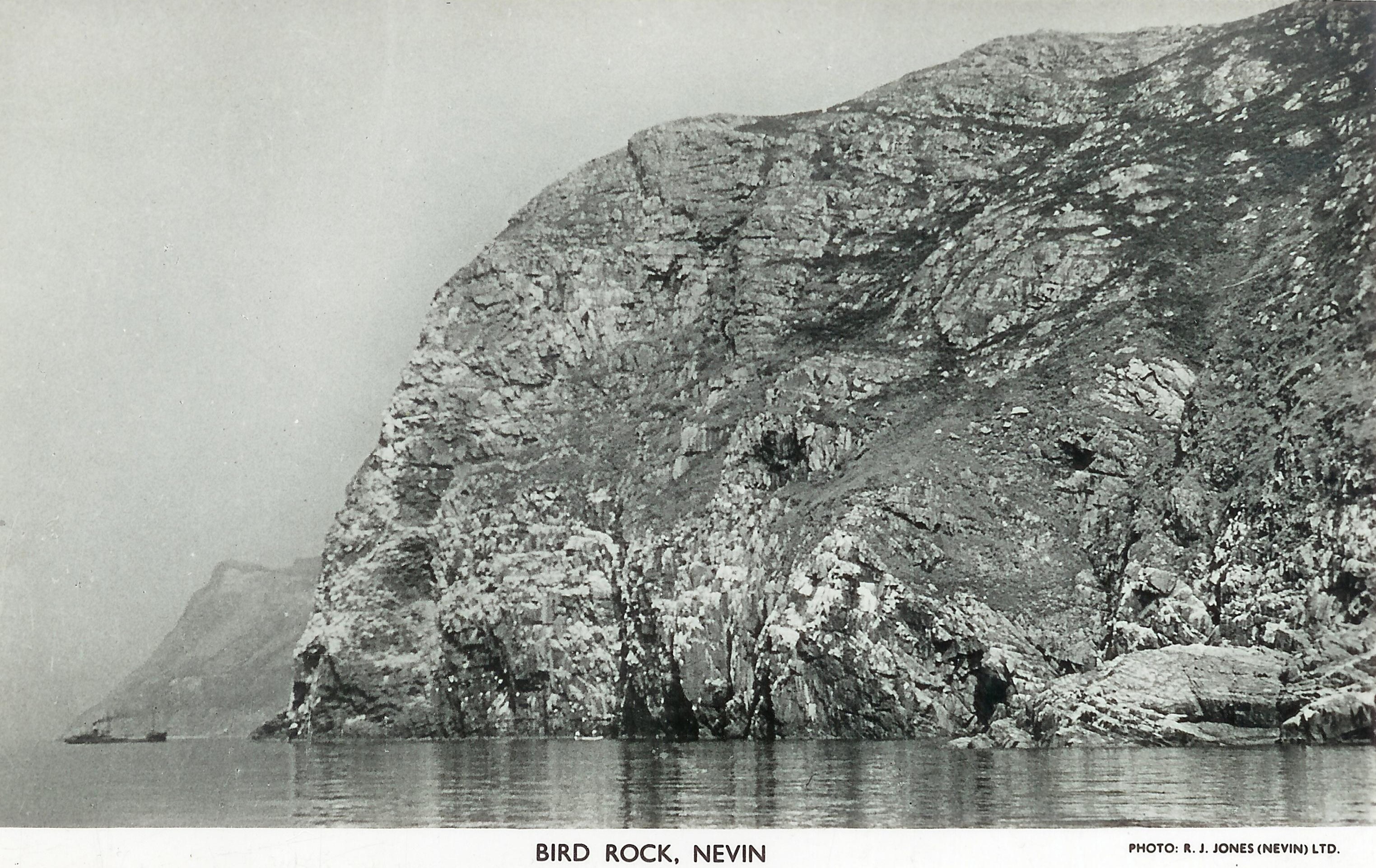
Bird Rock (Carreg y Llam) as seen from the direction of Nefyn Beach. It shows the Llech Lydan stack on the right and a company steamship on the left waiting in Bae Nant to load up at the Carreg y Llam Quarry pier. Please notice the boat at the bottom of the Rock with two persons aboard. The cave entrance is just to the right of the boat.
(Click photo to enlarge)
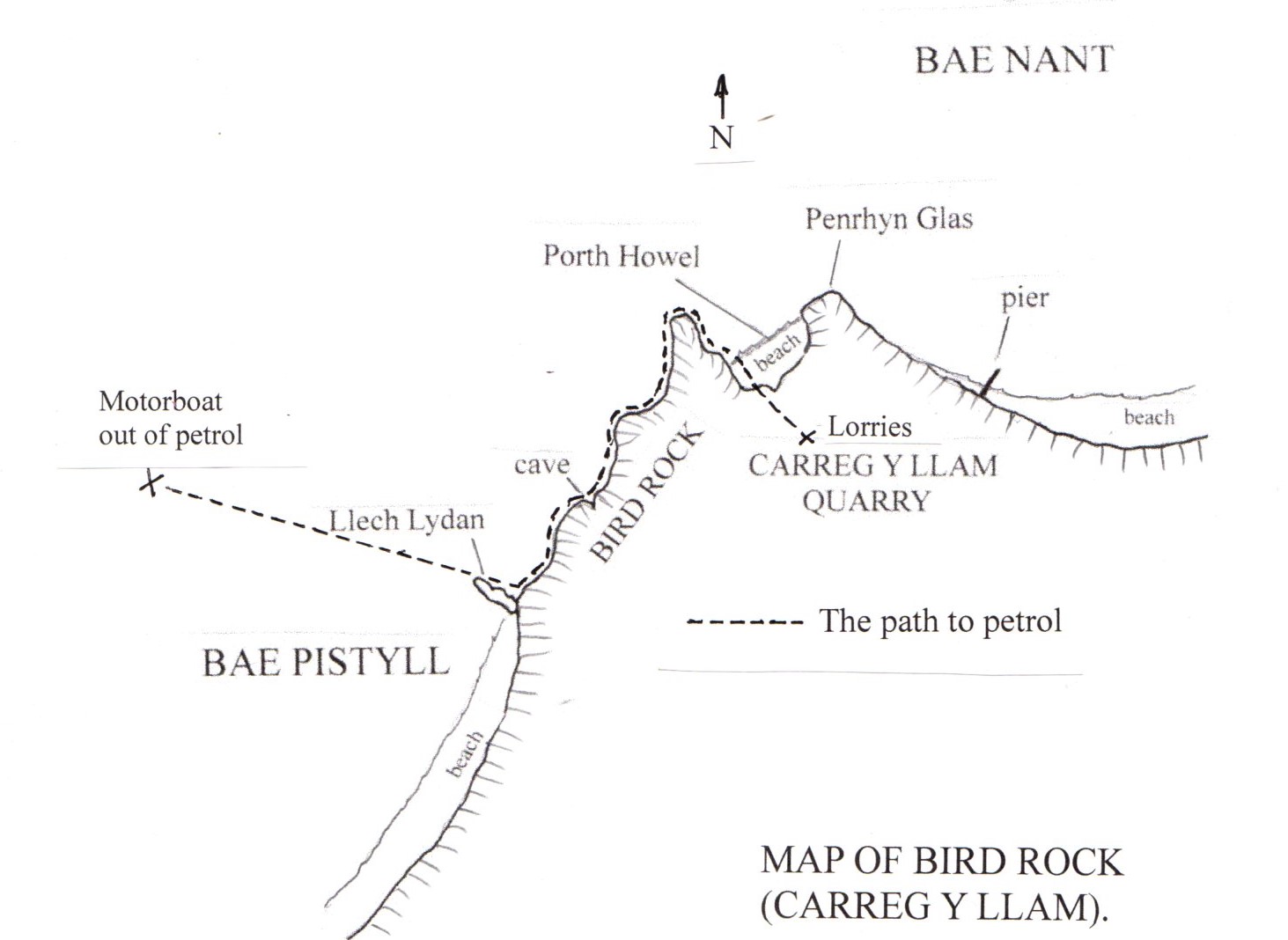
A rough map of the Bird Rock headland showing Llech Lydan, the Porth Howel cove and Penrhyn Glas.
(Click photo to enlarge)
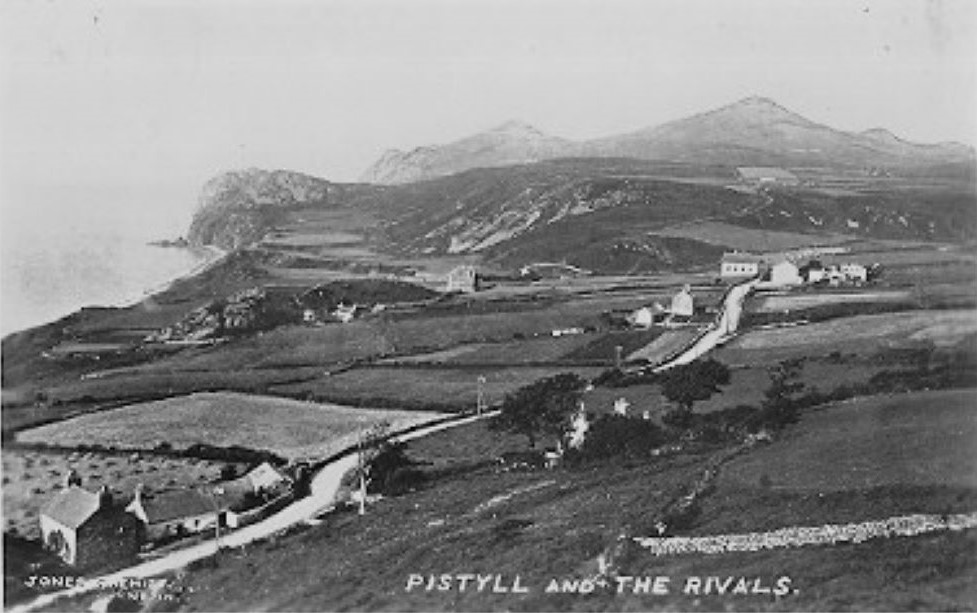
An early photo of Pistyll and the Rivals by Jones Chemist, Nevin in the 1930's. The Llech Lydan stack is seen protruding from the south side of Bird Rock on the left side of the photo. Plas Pistyll Hotel is in the center of the photo and Pistyll Farm just beyond it.
(Click photo to enlarge)
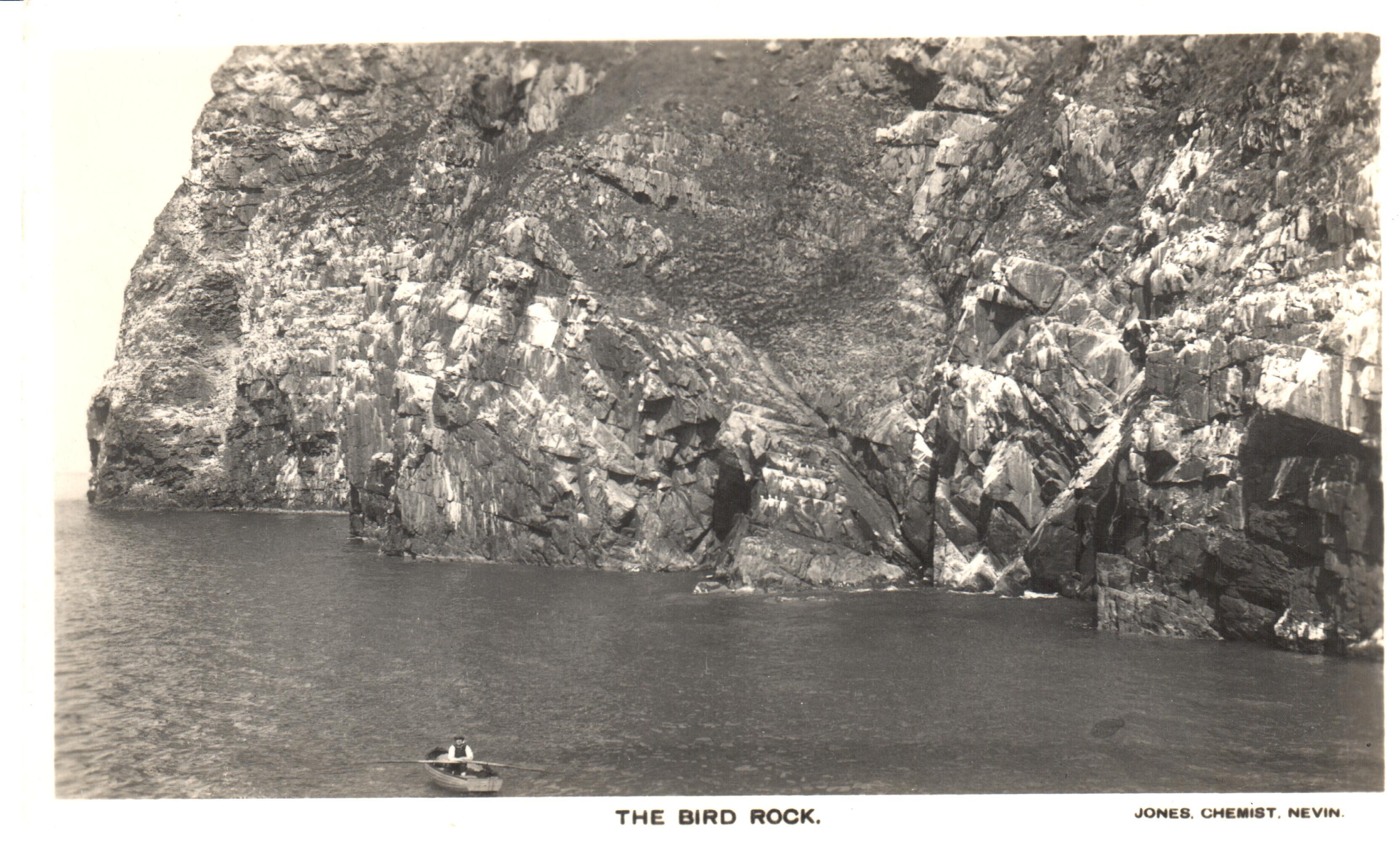
An old photo taken from a boat mast by Jones Chemist, Nevin in the 1930's with a boat being rowed in front of Bird Rock. The photo shows the nature of the Rock face at sea level and how we had to claw along to reach the quarry on the other side.
(Click photo to enlarge)
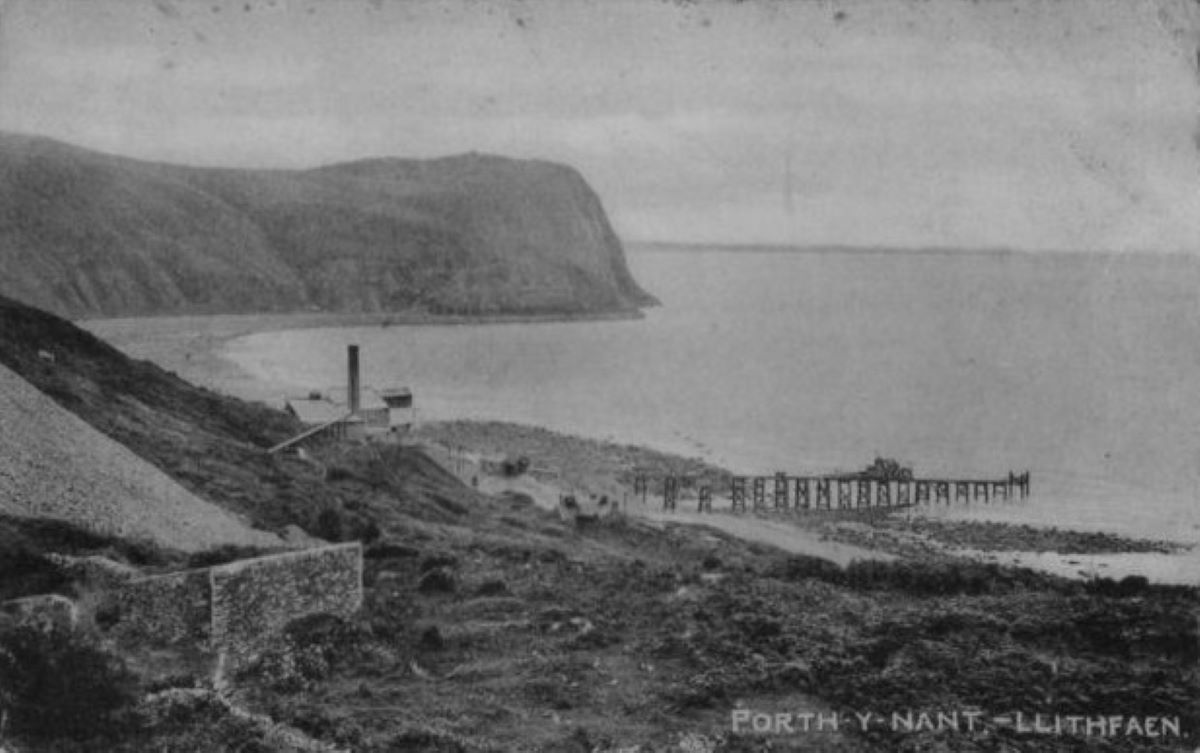
A pre -1911 view, by John Richard Owen, of the north side of Bird Rock from the Porth y Nant pier in Nant Gwrtheyrn. The view shows the undisturbed view of the Penrhyn Glas headland this side of Bird Rock with Porth Howel showing between the two headlands in the center of the photo.
(Click photo to enlarge)
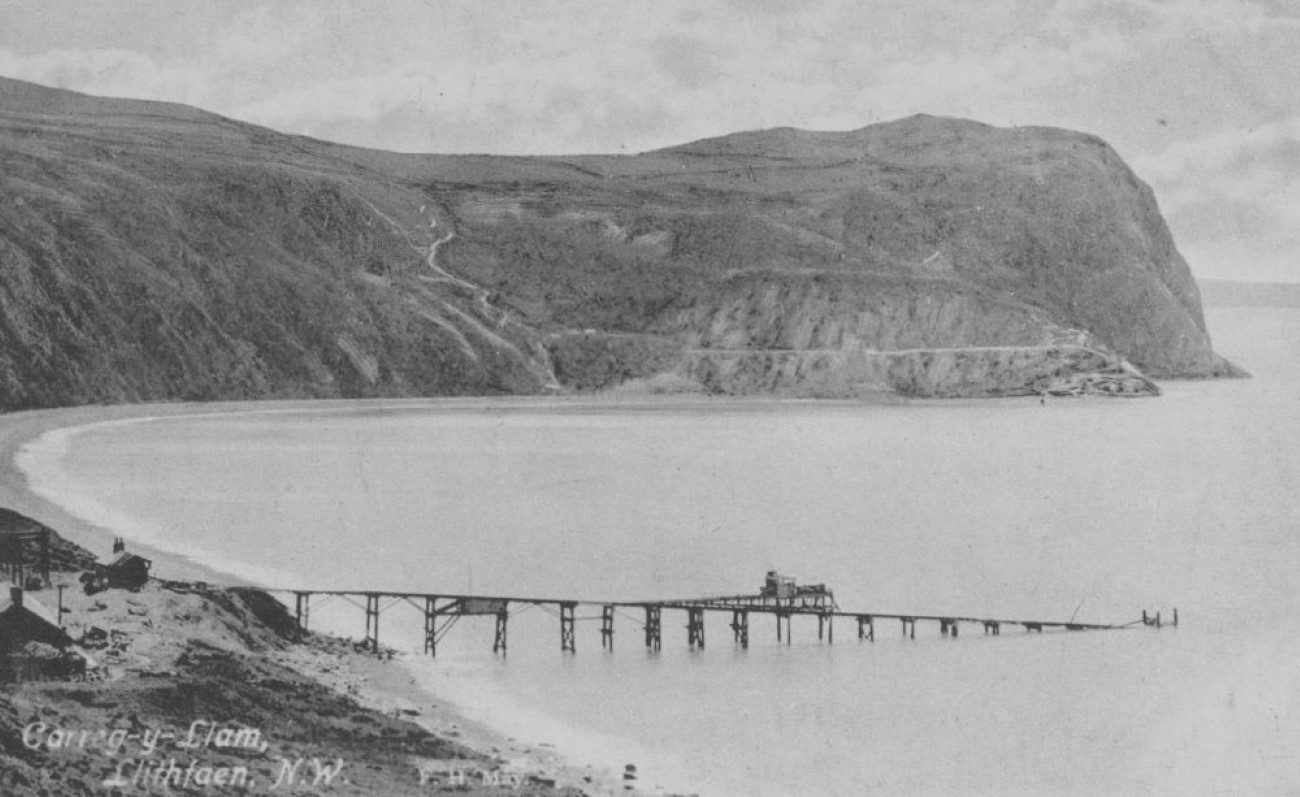
A post-1911 view, by Fred May, of the north side of Bird Rock from the Porth y Nant pier in Nant Gwrtheyrn. Quarrying has started on a gallery in the side of the Penrhyn Glas headland and Porth Howel is visible on the right between the two headlands.
(Click photo to enlarge)
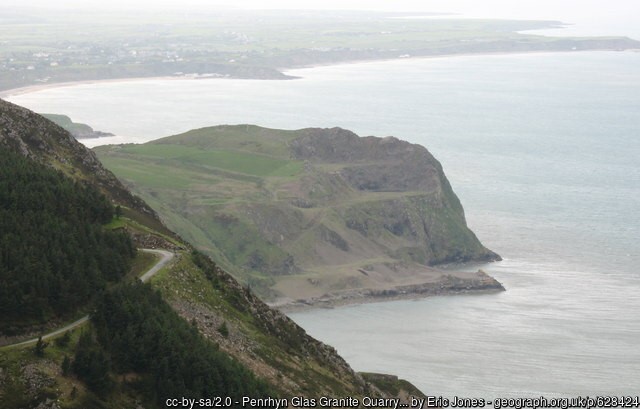
An Eric Jones photo taken from above Bae Nant of the north side of Bird Rock after quarrying in Carreg y Llam had ceased. It shows the four galleries at the quarry with the top two carved deeply into the back of Bird Rock. Penrhyn Bodeilias shows just above Bird Rock on the left, Penrhyn Nefyn in the center and Penrhyn Porthdinllaen at the upper right where the lifeboat station is located.
(Click photo to enlarge)
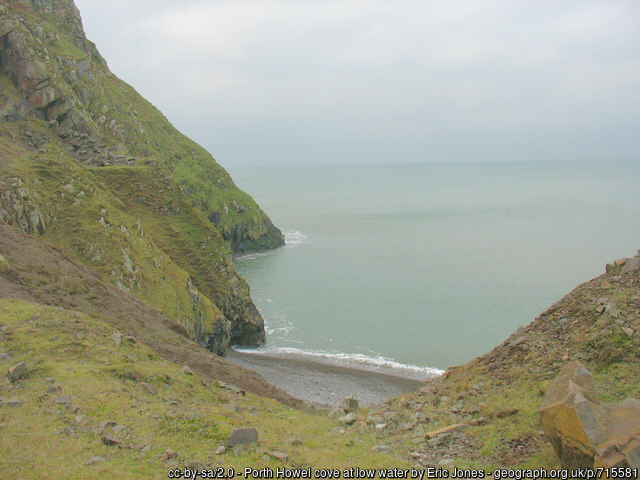
An Eric Jones photo taken in 2007 of the Porth Howel cove with Bird Rock on the left and what is left of the Penrhyn Glas headland on the right.
(Click photo to enlarge)
Dr. Brian Owen
Emmaus, PA, USA
Top of Page